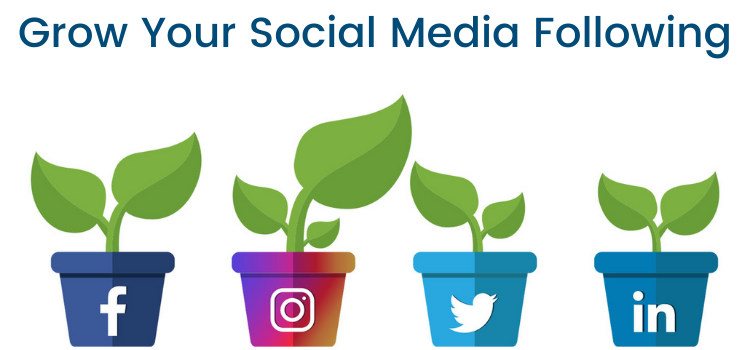The golden rule of social media: It’s about them, not about you.
In a very broad sense, all content posted on social media can be viewed as either talking about yourself or sharing information that benefits others. To be a winner in the long term you need to be the one who provides useful information. And most people, particularly younger social users, want value from the brands they follow.
Here are some recommendations for growing your following on social media in the coming year.
- Be follow-worthy. It’s not enough to have a ton of content or really flashy graphics. If you’re inauthentic you won’t get very far. People want to find meaning in the companies they follow.
- Use automation. You can manage all your social media accounts in one place. You can schedule posts weeks in advance and post at preferred times so the greatest number of users will see them. You can also analyze how well your posts are doing. Using the best tools like Hootsuite, HubSpot, Sprout Social or Buffer to help with your social media accounts will help ensure you’re posting with adequate frequency to expand your presence and increase your follower count.
- Focus on customer service. Many customers having issues with a brand are turning to social media to get help rather than waiting for a response to an email or making a phone call. So focus on helping people. These are people who will become repeat customers and be willing to buy from again if they know they can trust that you’ll help them with any issues. By using a social platform for customer service more users will go to your social account, and by having customer service available there you are making it easier for them to solve their problems.
- Promote your social media accounts. Make it easy to follow or like your profiles. Regularly perk up your startup’s Facebook page, Instagram, or Twitter account. Ask your customers to interact with you. Add social media icons to your site; add social feeds to your sidebar. Ask people to follow you on your social platforms at the end of your blog posts. Promote these accounts in your email marketing.
- Actively engage. Use your social media accounts to foster a community. Start by actively engaging your audience, reply to all comments. Post and answer questions in posts. Not only will you increase your presence but you’ll also develop real relationships with your audience.
- Keep an eye on the competition. You want to know who they are, where they are, what they’re doing, what they used to do, how well they’re doing, and if they pose a threat to your business. This all also helps you identify gaps in your strategy. Also find out what networks they’re on, how big their audience is, how often they post, how much engagement they get, what they’re good at and not so good at. Do they pose a competitive threat to you?
- Know what’s being said on social media. Listen for mentions of your brand and then track, analyze, and respond to those conversations. More broadly you should monitor conversations that are relevant to your industry and the thought leaders who impact it.
- Establish your social media voice and tone. Remember that every time you talk, write, design, post, respond, launch, thank, and connect with others you’re exercising your brand voice. People are building an impression of your brand. Make the reader the hero in your story. Write from their perspective. Be clear so readers know what they can get that benefits them. Be clear over clever, avoid sensationalism and drop the drama.
- Select the best channels to be on. Research and understand the best platforms for your business to spend time on. Here are the top 4:
- Facebook sends more website referral traffic than anybody and is geared towards both news and entertainment. FB tips: Use hashtags sparingly and try to work them directly into your copy. Upload video directly because they want you to stay on Facebook rather than leaving to consume content elsewhere. Keep your copy concise and avoid an overly promotional tone. Facebook’s algorithm limits the reach on any posts that sound too much like ads. Be sure your About section is complete.
- Twitter views itself as a news platform & social network and is well-suited to sharing blog posts or promoting website content. Twitter Tips: Respond to all comments. That’s always important but especially so on Twitter. Avoid hashtag spam. Use images to drive engagement. Automate your Twitter schedule since this is a high-volume network and requires lots of posts consistently each day to be successful.
- Instagram is highly visual and is not optimal for driving blog or website traffic. It’s best suited for strong visual brands. Instagram tips: Use location tagging on posts. Use hashtags, but don’t overdo it, making sure your hashtags are relevant to your post. Strive for authenticity rather than being sales-y. People come to Instagram to be inspired and entertained, so don’t simply promote your brand in an attempt to gain followers.
- LinkedIn is a professional network used heavily for sharing industry articles and professional content. LinkedIn best practices: This is not the place for memes and GIFs, that’s for Twitter. Share informative industry news. Be sure to update job listings on your company’s LinkedIn page and keep your company’s About section is current.
- Be sincere and human. Especially when you encounter negative comments or feedback. The very best way to deal with negative commentary is to be empathetic. It can be tough to stay on the high road, but be genuine in your responses. For the long-term health of your social media presence, don’t be negative in your responses. And remember, you are communicating with real people. Use language your audience uses and respond so you sound like a real person, not a robot.
- Focus on quality over quantity. Yes, some social networks require a high volume of content to be worthwhile, Twitter comes to mind. But don’t forget quality always beats quantity. Don’t post for the sake of having posts up, that will not grow your audience. Be sure every post is connected to a broader goal or objective.
- Ignore the haters. In the event that your brand grows large enough to have fans and haters, the best advice is to ignore the negativity. But remember it can be difficult to distinguish actual customer complaints from trolls. An actual complaint will have reasoning behind it, there will be a problem you can solve. Troll complaints have no basis. They are just seeking to provoke. You cannot make them happy and that’s their entire point in trolling you. It does not make sense, it just is. So ignore trolls.
Remember getting more followers means it’s not about the type of content you’re producing. It’s about who you are. You have to show you’re trustworthy and reliable to grow your social following.




